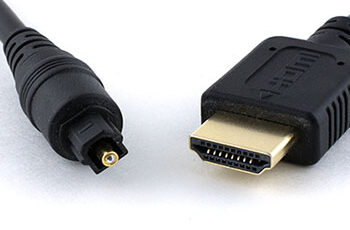If you have recently bought a soundbar or home theatre audio system, then you probably have noticed the availability of two common connectors that are also found on your TV: HDMI ARC and optical.
You also might be wondering whether you should use HDMI ARC or optical to connect the audio system to your TV.
While both interfaces can transmit high-fidelity audio with ease, there are a few differences that you should be aware of.
If you want to get the best out of your audio system, you can check out this comparison guide between the HDMI ARC vs Optical to learn more about them.
HDMI ARC vs Optical: What are the Differences?
HDMI, or High-Definition Multimedia Interface, is currently the industry standard for uncompressed video and audio transmission.

You will find an HDMI port in all current-gen TVs, monitors, projectors, home theatre speaker hubs, soundbars, game consoles, and several other AV equipments.
Optical is a rather old interface that has gone through several revisions since the ’80s. It can only carry audio from one device to another over reasonably short distances, and it doesn’t have support video signal transmission.
You will still find an optical audio port in most televisions and audio devices, but its use case is quite limited compared to HDMI.
Cables that carry optical audio are generally known as TOSLINK (Toshiba Link). While a regular user won’t be able to notice any difference in audio quality over HDMI or TOSLINK, there are a handful of exceptions.
HDMI cables use twisted copper pair wiring for signal transmission, which is prone to external interference, especially if there’s a power source nearby generating electromagnetic fields.
However, most HDMI cables use EMI shielding nowadays, which significantly decreases the chances of audio and video signal corruption caused by external interferences.
On the other hand, optical TOSLINK cables are less prone to such interferences, as they are non-metallic and use glass threads for signal transmission. Although optical audio cables are immune to electrical noise, they are quite fragile compared to HDMI cables.

Since you will probably put the soundbar or the home theatre hub below your TV, you can avoid quality loss over HDMI by using a shorter cable.
Fiber-optic HDMI cables also exist, but they are really expensive and offer no benefits for audio transmission.
Should I Connect my Soundbar with HDMI or Optical?
The ARC label next to the HDMI port on your home theatre hub, soundbar, or television stands for Audio Return Channel. It was introduced with the release of the HDMI 1.4 interface, making it easier for the consumers to use external audio devices for their home cinema setups.
HDMI ARC can carry high-quality video and audio data downstream from an audio source to a TV or soundbar.
In simple words, you can plug in your streaming device, Blu-Ray player, game console, and other devices to your TV via HDMI, then channel all the audio outputs to the home theatre audio system or soundbar over HDMI ARC from your TV.
It eliminates the need to connect all of your devices individually to your audio system. Assuming that you have a TV manufactured after 2009, you can expect HDMI ARC to work out of the box.
It technically does kill the use of optical cables as well. However, if you have an older audio device that doesn’t support HDMI ARC, you can use a TOSLINK optical cable to connect it to your TV’s optical port.
If your audio device supports multi-channel, high-quality audio formats like Dolby Digital and DTS, make sure to connect it to your TV’s HDMI (ARC) port.
However, note that ARC can’t bitstream high-resolution audio codecs like Dolby Atmos, DTS-HD Master Audio, Dolby TrueHD, and DTS-HD Master Audio found on Ultra-HD Blu-rays. For that, HDMI eARC (Enhanced Audio Return Channel) will be needed, which has been added to the new HDMI 2.1 interface.
eARC is the second iteration of ARC, which offers a significant boost in bandwidth. However, HDMI 2.1 inputs are found only in a few top-of-the-line audio and video devices, so support for eARC is quite limited as of now.
Unlike ARC, you will need a special HDMI with Ethernet cable to get eARC working, as it requires extra bandwidth to carry the high-resolution audio codec signals.
Optical cables can carry up to 5.1 compressed audio signals, and they are incompatible with 7.1 home theatre audio systems due to the bandwidth limitations of the interface.
HDMI ARC vs Optical (TOSLINK): Comparison Chart
[su_table responsive=”yes” alternate=”no”]
| Features | Optical (TOSLINK) | HDMI ARC | HDMI eARC |
| Cable | Optical (S/PDIF) | HDMI | HDMI with Ethernet |
| Max Audio Bandwidth | ~384 Kbits/second | ~1 Mbits/second | 37 Mbits/second |
| 5.1 Support (Compressed) | Yes | Yes | Yes |
| 5.1 Support (Uncompressed) | No | No | Yes |
| 7.1 Support (Uncompressed) | No | No | Yes |
| High-Bitrate, Object-Based Audio Support (e.g., DTS:X, Dolby Atmos) | No | No | Yes (up to 192kHz, 24-bit) |
| CEC Support | No | Yes | Yes |
[/su_table]
Also, Read
- Best External Hard Drive for TV Recording
- How to Get HDMI Input on Laptop
- Best SCART to HDMI Converters
Final Thoughts
If you have recently purchased a high-end home theatre audio system, then HDMI ARC is your best bet.
You can buy and use any HDMI cable you want for ARC functionality. As long as you have an HDMI port on your TV labeled as “ARC-compatible,” everything should work without manual setup.
On select TV models, you might have to enable HDMI ARC manually from the settings.
You can also use the optical TOSLINK interface for audio output, but it should be considered a secondary option in case HDMI ARC doesn’t work out for you.
